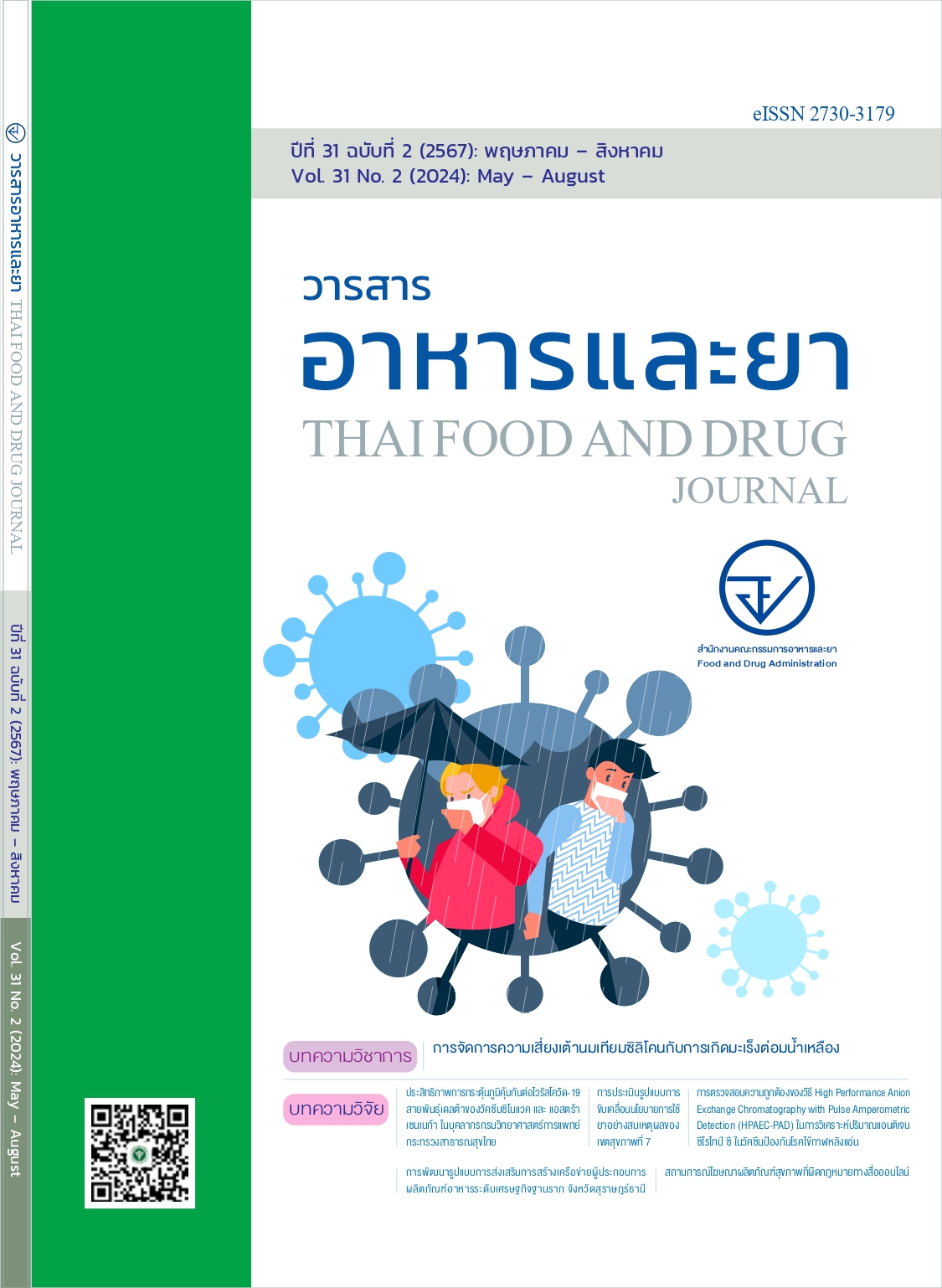การประเมินรูปแบบการขับเคลื่อนนโยบายการใช้ยาอย่างสมเหตุผลของเขตสุขภาพที่ 7
Main Article Content
บทคัดย่อ
ความสำคัญ: การใช้ยาไม่สมเหตุผลเป็นปัญหาสำคัญระดับโลกที่ส่งผลให้เกิดความสิ้นเปลืองค่ารักษาพยาบาลและเพิ่มโอกาสเสียชีวิตจากการติดเชื้อดื้อยาสูงขึ้น องค์การอนามัยโลกจึงเรียกร้องให้ประเทศต่าง ๆ ดำเนินการตามนโยบายพื้นฐานที่จำเป็นเพื่อให้เกิดการใช้ยาอย่างเหมาะสม ซึ่งในปี 2559 ประเทศไทยโดยกระทรวงสาธารณสุขได้มีการกำหนดนโยบาย RDU Service Plan เริ่มดำเนินการเฉพาะในโรงพยาบาลรัฐ และในปี 2565 ได้ขยายการดำเนินงานลงสู่ชุมชนโดยกำหนดเป็นตัวชี้วัดจังหวัด RDU (RDU Province) ซึ่งมีตัวชี้วัดการดำเนินงานที่ซับซ้อนตั้งแต่ระดับตำบลจนถึงระดับจังหวัด ส่งผลให้การดำเนินงานในช่วงแรกยังไม่ประสบความสำเร็จตามเป้าหมาย ผู้วิจัยจึงศึกษารูปแบบในการขับเคลื่อนนโยบายและมาตรการสำคัญที่จะส่งผลให้เกิดความสำเร็จตามเป้าหมาย โดยทำการศึกษาในพื้นที่เขตสุขภาพที่ 7
วัตถุประสงค์: เพื่อศึกษาสภาพปัญหาการขับเคลื่อนนโยบายการใช้ยาอย่างสมเหตุผลของเขตสุขภาพที่ 7 ปี 2566 เพื่อพัฒนารูปแบบการขับเคลื่อนนโยบายการใช้ยาอย่างสมเหตุผลของเขตสุขภาพที่ 7 และเพื่อประเมินรูปแบบการขับเคลื่อนนโยบายที่พัฒนาขึ้น
วิธีการวิจัย: เป็นการวิจัยและพัฒนาในพื้นที่จังหวัดกาฬสินธุ์ ขอนแก่น มหาสารคาม และร้อยเอ็ด ระหว่างเดือน มีนาคม.- ธันวาคม.2566 โดยเก็บรวบรวมข้อมูลด้วยการสัมภาษณ์ผู้รับผิดชอบงาน RDU ระดับจังหวัด ศึกษาข้อมูลทุติยภูมิจากระบบคลังข้อมูลด้านการแพทย์ (Health Data Center: HDC) และฐานข้อมูลสรุปผลการตรวจราชการ นำปัญหามาจัดทำเป็นโมเดลของรูปแบบการขับเคลื่อนนโยบายการใช้ยาอย่างสมเหตุผล และประเมินรูปแบบที่พัฒนาขึ้น โดยใช้แบบสอบถามความเห็นจากกลุ่มตัวอย่างเภสัชกรที่มีหน้าที่ควบคุมกำกับและดำเนินงาน RDU ในเขตสุขภาพที่ 7 จำนวน 64 ตัวอย่าง
ผลการศึกษา: การศึกษาสภาพปัญหาในการดำเนินงานที่ได้จากการสัมภาษณ์และรายงานการตรวจราชการสามารถแบ่งปัญหาที่ทำให้การดำเนินงานไม่บรรลุเป้าหมาย เป็น 3 ระดับคือ ระดับต้นน้ำ RDU ในชุมชน (RDU community) ระดับกลางน้ำเป็นเรื่อง RDU ในสถานพยาบาล (RDU Hospital และ RDU PCU) ระดับปลายน้ำซึ่งเป็นส่วนของการพัฒนาให้เกิดอำเภอ RDU และจังหวัด RDU ( RDU district และ RDU province) ผู้วิจัยได้นำปัญหาส่วนขาดและแนวทางการจัดการจากงานวิจัยที่เกี่ยวข้อง มาพัฒนาเป็นรูปแบบการขับเคลื่อนนโยบายการใช้ยาอย่างสมเหตุผลของเขตสุขภาพที่ 7 โดยจัดทำเป็นกรอบ Matrix scoring : Topic RDU province เขตสุขภาพที่ 7 ซึ่งประยุกต์มาจากเครื่องมือตรวจราชการ Matrix scoring inspection ของเขตสุขภาพที่ 11 โดยแต่ละส่วนมีการกำหนดมาตรการสำคัญที่เกี่ยวข้องที่ใช้ในการขับเคลื่อนกิจกรรมที่จะทำให้บรรลุตัวชี้วัดในแต่ละระดับ โดยระดับต้นน้ำ กำหนดมาตรการที่จะส่งผลให้เกิดRDUในชุมชนเช่น การไม่ขายยาอันตรายในร้านชำ การลดใช้ยาในภาคการเกษตร รวมถึงการบังคับใช้กฎหมายเช่นกรณีขายยาชุด กลางน้ำกำหนดมาตรการควบคุมกำกับให้เกิด RDU ในส่วนของสถานพยาบาลทั้งภาครัฐและเอกชนโดยการพัฒนาศักยภาพบุคคลากรที่สั่งใช้ยาให้เป็นไปตามเกณฑ์กำหนด ส่วนปลายน้ำเป็นการกำหนดนโยบายระดับอำเภอที่เชื่อมโยงถึงชุมชนและมีการกำหนดผู้รับผิดชอบงานชัดเจน จากนั้นให้กลุ่มตัวอย่างประเมินความสอดคล้องและความเหมาะสมในการนำไปใช้โดยใช้กรอบการประเมินแบบ CIPP Model พบว่า กลุ่มตัวอย่างมากกว่าร้อยละ 70 มีความเห็นว่ามาตรการสำคัญตามกรอบ Matrix scoring ที่พัฒนาขึ้นมีความสอดคล้องกับนโยบาย RDU มีความเป็นไปได้ในทางปฏิบัติและเป็นมาตรการสำคัญที่จะส่งผลให้บรรลุเป้าหมายตัวชี้วัดได้
สรุป: รูปแบบที่พัฒนาขึ้นมีความสอดคล้องเหมาะสมที่จะนำไปใช้เป็นแนวทางในการขับเคลื่อนนโยบายการใช้ยาอย่างสมเหตุผลของเขตสุขภาพที่ 7
Article Details

อนุญาตภายใต้เงื่อนไข Creative Commons Attribution 4.0 International License.
เอกสารอ้างอิง
World Health Organization. Promoting rational use of medicines: core component. In: WHO Policy perspectives on medicines. No.5 [Internet]. Geneva: WHO; 2002 Sep [cited 2024 May 26]. Available from: https://iris.who.int/bitstream/handle/10665/67438/WHO_EDM_2002.3.pdf
นิธิมา สุ่มประดิษฐ์, ศิริตรี สุทธจิตต์, สิตานันท์ พูลผลทรัพย์, รุ่งทิพย์ชวนชื่น, ภูษิต ประคองสาย. ภูมิทัศน์ของ
สถานการณ์และการจัดการการดื้อยาต้านจุลชีพในประเทศไทย. กรุงเทพ: อักษรกราฟฟิคแอนด์ดีไซน์; 2558.
ภาณุมาศ ภูมาศ, ตวงรัตน์โพธะ, วิษณุธรรมลิขิตกุล, อาธร ริ้วไพบูลย์, ภูษิต ประคองสาย, สุพล ลิมวัฒนานนท์. ผลกระทบด้านสุขภาพและเศรษฐศาสตร์จากการติดเชื้อดื้อยาต้านจุลชีพในประเทศไทย: การศึกษาเบื้องต้น. วารสารวิจัยระบบสาธารณสุข. 2555;6(3):352-360.
คณะกรรมการพัฒนาระบบยาแห่งชาติ. นโยบายแห่งชาติด้านยา พ.ศ. 2554 และยุทธศาสตร์การพัฒนาระบบยาแห่งชาติ พ.ศ. 2555-2559. พิมพ์ครั้งที่ 2. กรุงเทพฯ: อักษรกราฟฟิกแอนด์ดีไซน์; 2555. หน้า 7- 11.
สำนักบริหารการสาธารณสุข. การพัฒนาระบบบริการสุขภาพสาขาการพัฒนาระบบบริการให้มีการใช้ยาอย่างสมเหตุผล (Service Plan : Rational Drug Use).นนทบุรี: สำนักงานปลัดกระทรวงสาธารณสุข. 2559.
สำนักงานคณะกรรมการสุขภาพแห่งชาติ. การจัดการเชิงระบบสู่ประเทศใช้ยาอย่างสมเหตุผล โดยชุมชนเป็นศูนย์กลาง. เอกสารนำเสนอในการประชุมมติ 4: สมัชชาสุขภาพแห่งชาติครั้งที่ 12; 20 ธ.ค. 2562; ศูนย์ประชุมวายุภักษ์ ศูนย์ราชการเฉลิมพระเกียรติ 80 พรรษา, กรุงเทพฯ.
กองยุทธศาสตร์และแผนงาน. แผนยุทธศาสตร์ชาติ ระยะ 20 ปี ด้านสาธารณสุข ประจำปีงบประมาณ พ.ศ. 2561 [อินเทอร์เน็ต]. นนทบุรี: สำนักงานปลัดกระทรวงสาธารณสุข. 2561 [เข้าถึงเมื่อ 5 ธ.ค. 2566]. เข้าถึงได้จาก: https://spd.moph.go.th/wp-content/uploads/2022/09/strategymoph61_v10.pdf
กองยุทธศาสตร์และแผนงาน. รายละเอียดตัวชี้วัดกระทรวงสาธารณสุข (ฉบับปรับปรุง ครั้งที่ 2) ประจําปีงบประมาณ พ.ศ. 2566 [อินเทอร์เน็ต]. นนทบุรี: สำนักงานปลัดกระทรวงสาธารณสุข. 2566 [เข้าถึงเมื่อ 5 ธ.ค. 2566]. เข้าถึงได้จาก: https://spd.moph.go.th/wp-content/uploads/2023/02/kpi_template_edit_2.pdf
Turner R, Carlson L. Indexes of item-objective congruence for multidimensional items. International Journal of Testing [Internet]. 2003 [cited 2024 May 26];(3):163-171. Available from: https://www.tandfonline.com/doi/abs/10.1207/S15327574IJT0302_5 doi: 10.1207/S15327574IJT0302.
พิทักษ์พล บุณยมาลิก. Matrix Scoring Inspection. เอกสารนำเสนอในการประชุมชี้แจงแผนการตรวจราชการกระทรวงสาธารณสุขประจำปีงบประมาณ 2564; 22 ธ.ค. 2563; โรงพยาบาลสุราษฎร์ธานี: สุราษฎร์ธานี.
กุลธน ธนาพงศธร. แนวคิดทั่วไปเกี่ยวกับนโยบายสาธารณะ. นโยบายสาธารณะและการวางแผน. พิมพ์ครั้งที่ 9. นนทบุรี: สุโขทัยธรรมาธิราช; 2562.
กมลรัตน์ นุ่นคง. การพัฒนารูปแบบการส่งเสริมการใช้ยาอย่างสมเหตุผลในชุมชนเพื่อความปลอดภัยจากการใช้ยาของประชาชน ในเขตพัฒนาพิเศษภาคตะวันออก [ดุษฎีนิพนธ์]. ชลบุรี: คณะสาธารณสุขศาสตร์ มหาวิทยาลัยบูรพา. 2565.
กัณฐนวรรธน์ รอนณรงค์. ผลการดำเนินงานและพัฒนาแนวทางการส่งเสริมการใช้ยาอย่างสมเหตุผลระดับจังหวัดของคณะกรรมการพัฒนาระบบบริการให้มีการใช้ยาอย่างสมเหตุผล จังหวัดชัยภูมิ. ชัยภูมิเวชสาร 2562;41(1): 62-67.
สุมาลี ท่อชู, รุ่งทิวา หมื่นปา. ผลลัพธ์ของการดำเนินโครงการโรงพยาบาลส่งเสริมการใช้ยาอย่างสมเหตุผลในอำเภอหนองหงส์ จังหวัดบุรีรัมย์. วารสารเภสัชกรรมไทย 2562;9(2):467-471.
บุญธรรม กิจปรีดาบริสุทธิ์. ระเบียบวิธีการวิจัยทางสังคมศาสตร์. พิมพ์ครั้งที่ 10. กรุงเทพฯ: จามจุรีโปรดักท์; 2551.


